Vehicle Intrusions
Introduction
The Vehicle Intrusions Toolbox addresses land based motor vehicles, aircraft (including drones and paragliders), snowmobiles, motorboats, and bicycles (including other wheeled conveyance).
Vehicle intrusions take many forms. They may be intentional or inadvertent. They may occur through recreational, commercial, or managerial activities. They may occur with motor vehicles over land; snowmobiles, aircraft, motorboats, paragliders, bicycles, game carts; or similar vehicles or variances of each. These are considered “intrusions” because the Wilderness Act prohibits these uses under Section 4(c).
“…except as necessary to meet minimum requirements for the administration of the area for the purpose of this Act… there shall be… no use of motor vehicles, motorized equipment or motorboats, no landing of aircraft, no other form of mechanical transport…”
Entry with an unauthorized vehicle, constitutes a wrongful entry of the Wilderness. This toolbox provides information useful for managers to addressing the issue of vehicle intrusions by land or air.
Definitions
- Motor vehicles – Any means of transportation of persons or belongings on or immediately over land, snow, or other natural terrain, that is powered by a motor, engine, or other non-living power source.
- Motorboat – Any means of transportation over water that is powered by a motor, engine, or other non-living power source.
- Aircraft - any device that is used or intended to be used for flight in the air
- Landing of aircraft – Bringing down to or raising up from the surface of the earth (land, water, snow, or ice) any persons or belongings, through the air, whether or not the aircraft is motorized or passive (e.g. a parachute). Aircraft use in the air over wilderness areas is not regulated by the Wilderness Act.
- Mechanical transport – Any vehicle, device, or contrivance for moving persons or belongings over land, water, snow, ice, or air that has moving parts as essential components of the transport and which apply a mechanical advantage, regardless of the power source.
- Wheelchair – A device designed solely for use by a person with a mobility impairment, who requires such use for locomotion, and that is suitable for use in an indoor pedestrian area.
Introduction
Vehicle use in wilderness is an intrusion that has significant impacts on visitor’s experiences and the biological and physical resources of wilderness. The Wilderness Act provides a policy goal statement in Section 2(a) stating that the Act’s intent is to “assure that an increasing population, accompanied by expanding settlement and growing mechanization, does not occupy and modify all areas within the United States.” Vehicles typify the “growing mechanization” with which the Wilderness Act is concerned. Vehicles also facilitate rapid occupation and modification of the land. Because they are inconsistent with these two policy goals for wilderness, the Wilderness Act includes specific prohibitions to permanent and temporary roads, the use of motor vehicles, motorboats, and mechanical transport, and the landing of aircraft. Six of the 10 prohibitions identified in Section 4(c) of the Wilderness Act are related to transportation.
Advancement of vehicles of all kinds has occurred since the passage of the Wilderness Act and was anticipated in the Wilderness Act by the description of “growing mechanization” In Section 2(a). The advanced mechanization of all forms of transportation coupled with an ever-increasing rate of ownership presents greater challenges for wilderness managers in preventing illegal use in wilderness. Motor vehicle capability has dramatically increased through advancing mechanization, and perhaps the most remarkable advancements have occurred with aircraft and bicycles.
Lightweight, inexpensive unmanned aircraft systems (commonly referred to as drones) are easy to fly and have the potential to easily carry things into wilderness. Currently their primary cargo is a camera, but someday advancements could make it possible to transport equipment, water, and food. This same technology is likely to make its way into human transport as well. Though illegal to operate in wilderness, prohibitions may be difficult to enforce.
When the Wilderness Act was passed in 1964, bicycles were heavy and ill equipped for use on typical wilderness trails. Since that time, the bicycle has undergone a remarkable transformation. Through redesign, lightweight alloys and composites, and a series of advancements in its mechanization (e.g. more capable drivetrains and suspension), the modern bicycle is a machine of significant capability.
Advancements similar to those found in bicycles are also seen in wheelchairs, and these advancements are a welcome improvement in access for those who depend upon mobility devices. Wheelchairs are allowed in wilderness for a person with a mobility impairment who requires such use. In regard to people with mobility impairments, think of a wheelchair as no different than another person’s boots; it’s what gets them around. The Americans With Disabilities Act of 1990 (ADA) describes that, to be allowed in wilderness, mobility devices must be designed solely for a person with a mobility impairment, and be suitable for indoor use. In other words, the provision in the ADA does not provide authorization for a person with a mobility impairment to drive, for example, an all-terrain vehicle in Wilderness. An internal combustion engine has no place indoors, and is likewise out of place in wilderness. Battery powered wheelchairs are allowed in wilderness if they are suitable indoors. As these devices evolve, managers will need to carefully distinguish between those that are appropriate indoors, such as those that do not mar floors, and those that are not. It will likely be through that test that a determination will be made as to which devices are appropriate in Wilderness. Keep in mind that for any mobility device to be allowable in wilderness, it must also be designed solely for a person with a mobility impairment. For more information on wheelchair use, visit the accessibility toolbox Wilderness Connect Accessibility Toolbox.
Special provisions exist for the use of all forms of motorized and mechanized vehicles in wilderness. They may be allowed when there is: (1) a valid existing right for the use; (2) through a unique special provision; or, (3) for administrative uses that are necessary to meet minimum requirements for the purpose of the Wilderness Act. There may be, for example, a valid existing right held by a specific person (such as a property owner) to drive into a wilderness for a specific purpose. Special provisions sometimes exist for public motor vehicle uses such as landing of aircraft and motorboat use. Finally, administrative use of motor vehicles may be the minimum necessary for preserving wilderness character (as determined through a minimum requirement analysis) or in cases of emergencies. It is only through these three conditions that motorized or mechanized vehicles may be allowed in wilderness.
Land-Based Motor Vehicles
The areas where land-based motor vehicle intrusion most frequently occurs is where vehicle-based recreation is active on lands surrounding the wilderness. In addition, motor vehicle intrusion is likely to be a significant issue with newly designated wilderness. Newly designated wilderness areas are not yet widely known and recognized by the public as closed to motor vehicles. Where previously existing motor vehicle travel routes are present and visible, they will attract use. On the ground management of boundaries to prevent vehicle incursions is a top priority of work immediately after a wilderness designation. To inform visitors, on-going boundary posting is important for all wilderness areas regardless of how long they have been designated.
The majority of motor vehicle operators want to do the right thing; in this case, to not drive into wilderness. The agency’s responsibility is to make it feasible, even easy, for visitors to avoid driving their vehicles into wilderness. A primary method of doing this includes signing and mapping. However, not every motor vehicle operator wants to do the right thing, and so more defensive approaches may be necessary.
The following eight wilderness boundary management approaches may help prevent land-based motor vehicle intrusions. They are listed in order of priority – the first approaches have wide application, while the later approaches are applicable case-by-case. In all situations, some combination of these approaches may be useful. These are provided for field practitioners to consider, but there may be other approaches not described here.
Informational boundary signs are an important tool in defending wilderness boundaries. Boundary signing should be strategized according to the setting. A wilderness boundary nearby lands where uses incompatible with wilderness occur (e.g. an off-highway vehicle area) may need closely placed signs. On the other side of the spectrum, a rugged and remote wilderness boundary well removed from areas of incompatible use may need no boundary signs at all.
Signs have two functions: 1) they inform visitors of the boundary to help foster compliance; and, 2) they provide notification (such as by displaying regulations) upon which law enforcement officers can cite violators. There are many forms of these signs within two categories: 1) kiosks or decorative signs placed at major wilderness access points (such as along trails); and, 2) general demarcation signs that are placed at regular intervals along the boundary. In all cases, consider positive and enforcement messages: include a welcoming message to visitors while at the same time providing necessary regulatory messages necessary for law enforcement.
See BLM example: Wilderness and WSA Decals
Informational boundary signs can and should be installed along wilderness boundaries prior to cadastral surveys. Informational boundary signs placed along boundary roads do not need survey precision to notify vehicle users and enforce boundaries as vehicle incursions tend to be gross violations where such precision is immaterial.
Boundary signs will require monitoring and maintenance.


A fiberglass sign post is durable, but is vulnerable to being laid down with a rock. After the rock is removed the sign appears functional (until the next time a rock is laid on it). Consider using a different post type in this location or installing a fence post to back up the sign, but install a second fencepost nest to it so that the presence of a fencepost is visible.
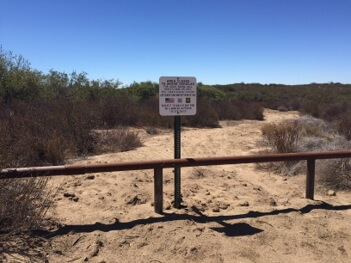
This sign provides information on alternative sites for motor-based recreationists to explore.
Ensure agency maps are available to depict wilderness boundaries. However, recognize that the agency is not the only map provider. Readily share accurate boundary information with all map providers as soon as possible after wilderness designation.
Note that with a new designation you should not wait for legal descriptions to be prepared before sharing data. It is better to provide the best information available to the public as soon as possible. A legislative map with a boundary line that may be adjusted later to correct errors in accuracy is better than not having a publicly available map. Provide a disclaimer on boundary accuracy in the legend.
Provide outreach to visitors and communities to help them understand appropriate uses of wilderness and create community buy-in. Describe Public Lands as a spectrum of resources, values and benefits, with wilderness filling a specific niche. Don’t just talk about wilderness, but also identify the continued availability of non-wilderness opportunities (for example, a nearby high-quality motorized trail).
Consider producing websites, information packets, fact sheets, brochures, and kiosks or informational signs at key areas. Many user groups and communities will incorporate this same information into their own maps and materials if you make it readily available to them.
Outreach is critical to improve the effectiveness of all other methods of preventing vehicle incursions. Work with partners, motorized and non-motorized user groups, vehicle manufacturers and suppliers, outfitters, guides, and local communities to communicate wilderness values and designations.
An important way to prevent use of unauthorized vehicle routes in wilderness is to make them disappear. A tried and effective method in making old vehicle routes disappear is transplanting native vegetation into the old routes to camouflage them; in essence creating a visual barrier. This technique is especially useful in more arid environments where dispersed low vegetation exists, as physical barriers in these places tend to be ineffective (drivers can easily drive around a barrier). If visitors are unable to discern the route they won’t drive on it. When repeated impact of vehicles ceases, vegetation is often able to reclaim the site within a few years without the need for more intensive restoration efforts. Sources of vegetation for the visual barrier are typically from the sides of open roads around the wilderness (sourcing vegetation from road edges creates very little impact). Even if the vegetation dies during transplanting, it often looks enough like the surrounding vegetation for enough time that drivers don’t discern it as a road, don’t drive on it, and natural seed dispersal and germination reclaims the site.
Transplanted vegetation (even if dead) helps to provide shade and retain soil moisture and provides texture in which naturally blown in seeds can germinate. If the site is also first prepped with picks to break up soil compaction and create small divots, this can help for better moisture retention and seed germination and facilitate recolonization of the site by native vegetation.
This technique can be done in conjunction with physical barriers and signing, but in many cases it’s better to not install barriers or signs because they can give away the site and attract unwanted continued use of the old route.
This approach is feasible to implement using hand tools, is cost effective, and the techniques can be quickly learned by novices, making it possible for this work to be taken on by volunteers. Development of this approach is supported by research and testing of intensive restoration including planting live nurserygrown native vegetation. It was observed that even when nursery-grown vegetation died, it still tends to prevent motor vehicle use. The approach of transplanting roadside vegetation that would likely die in the process could be quicker, less of an impact on wilderness character, and more cost effective than intensive restoration with nursey-grown plants. A meticulous attempt to mimic the appearance of the surrounding vegetation in texture, density, and variety, as well as incorporating rocks that blend with the surrounding geology and landscape in the same manner, further contribute to success.


Before and after of a reclamation site. Note the wilderness boundary sign is not a “road closed” sign. Every site is different, even placing this sign may be enough to attract attention, and so think through your strategy case by case. In this case it may be better to place the sign 50 feet away.
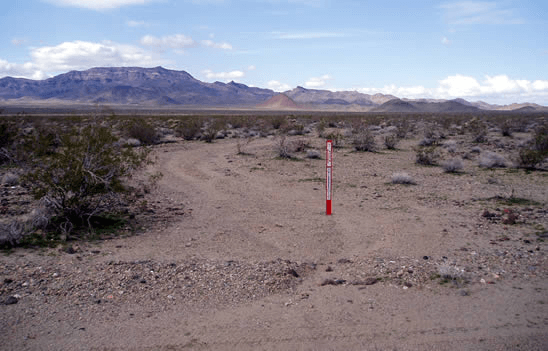
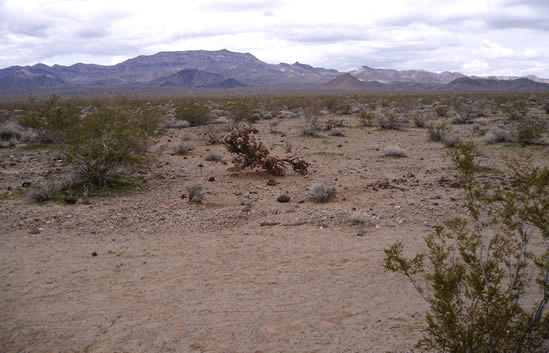
Before and after of a reclaimed vehicle route. Note the route closed sign has been removed to avoid attracting attention.
Note:
- Information about large restoration efforts is located at the end of this section.
- See the Ecological Intervention and Site Restoration Toolbox and the Small Scale Restoration section for more detailed information.
Conversion of what was formally a vehicle route to a non-motorized trail can be an effective method to preventing vehicle use of the route. Some wilderness enabling laws even include statutory requirements to develop a trail plan which would include considering such conversion. However, trails are an installation, and installations are prohibited unless they are the minimum necessary for the purpose of the Wilderness Act, that is to preserve wilderness character. Though trails are easily overlooked as a “normal” component to wilderness, conversion of a vehicle route to a non-motorized trail needs to be consistent with preserving wilderness character and should be screened through the following considerations:
- Is the route sustainable or is it causing unacceptable impacts to other resources? For example, if the route is causing unacceptable impacts to culture resources, is impacting a population of rare plants or is concentrating human use at limited water sources critical to wildlife, the route should be considered for removal and restoration. However, if the impact is limited, a short reroute to correct the problem may be appropriate.
- Does the route support a non-motorized recreational purpose? A route readily useable by foot or horseback visitors to access sites of interest or one that travels through the landscape in a way sought out for primitive recreation may be appropriate to manage as a trail. Motor vehicle hill climbs or routes that access past mineral exploration sites are examples of routes unlikely to provide for primitive recreation and should be removed.
- How does the route affect wilderness character, specifically the five tangible qualities: natural, untrammeled, undeveloped, opportunities for solitude or primitive and unconfined recreation, and other features of value? The route should be considered within the context of preserving wilderness as a whole, by considering all positive and negative impacts to each quality.
- Would the route be sustainable as a trail? Many former vehicle routes are steep, capture the flow of water, or traverse the landscape in ways that may cause excessive impacts without extensive ongoing maintenance. Modification or relocation of a portion of such a route may be sufficient to correct the problem. The need for extensive rerouting, however, should flag the route for closure and reclamation. There is no bright line between minor and extensive relocation; each situation will be uniquely considered in a Minimum Requirement Analysis.
- A former vehicle route converted to a non-motorized trail may produce better results for wilderness preservation than simple closure. A route that is closed may be likely to be trespassed on, while conversion to a trail used by hikers and horseback riders may be less comfortable for a motor vehicle operator to drive as they would be rebuked or reported by non-motorized visitors.
- Some pre-existing routes (motorized or non-motorized) may not be suitable for management as a system trail, but may also not be realistically closed and rehabilitated. These may remain open for use though they are not managed as a part of the trail system (not placed on visitor maps and visitors are not directed to them by other means). For example, a steep route to the top of a peak, or a route into a canyon in which solitude is being safeguarded. Visitors may continue to use these trails, but the trials would only receive monitoring and limited maintenance to prevent unacceptable resource impact.
- A new vehicle route established after wilderness designation is a trespass which needs to be restored and should not be converted into a trail.
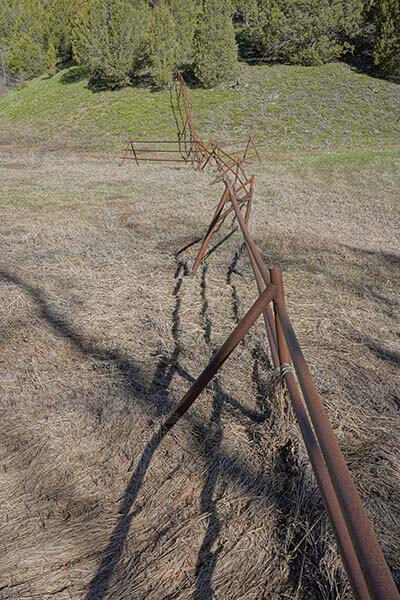
Fence tied into slope and vegetation coupled with a walk through (visible on the far side) turning the old vehicle route into a trail.
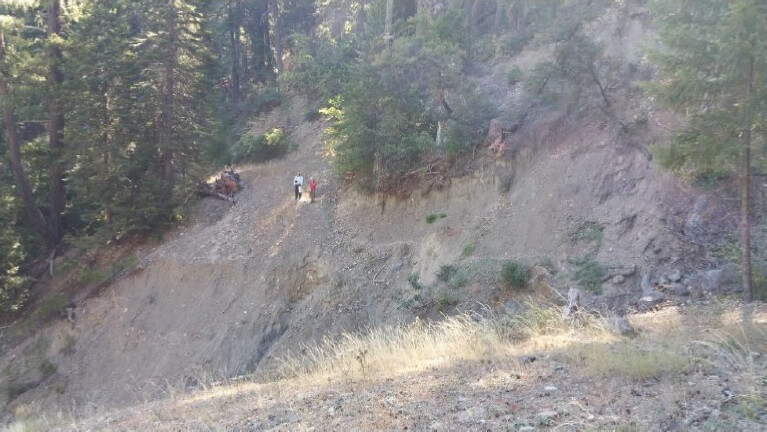

Site of old road, converted into trail where fill and culvert were removed. The road was converted to a hiking trail and new trail tread through restoration area was constructed.
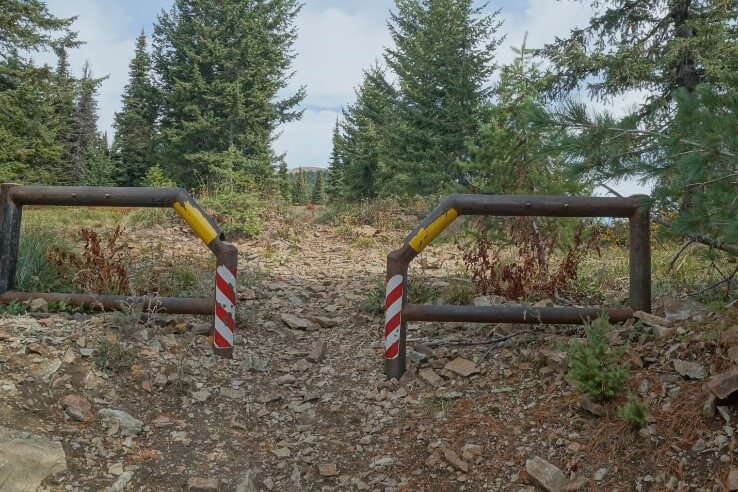
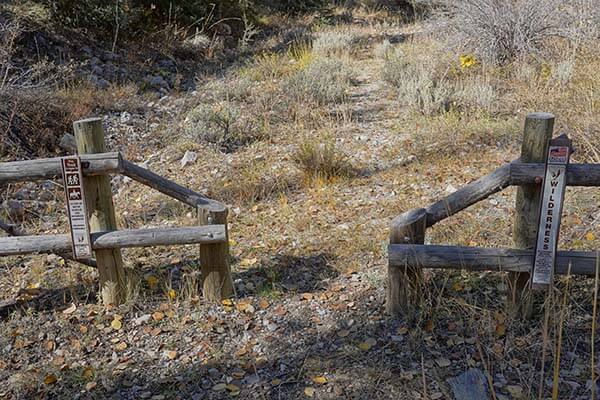
These barriers prevent motor vehicles while allowing for hikers and horse packers to pass. It is important to leave enough space so that a wheelchair can also pass.
If the decision is made to repurpose an old vehicle route to a hiking and horseback riding trail, it is important to also present it as a trail by providing trailhead parking defined with barriers, signs and kiosk as appropriate, and take measures to reduce the trail to a single tread.
Note:
- See the Signs and Kiosks Toolbox for more detailed information.
It is important to couple law enforcement presence with physical work toward preventing vehicle intrusions. Include in budgets regular patrols, overtime, and specialized equipment. Work with law enforcement officers to prioritize patrols, gain their input to project implementation, and get their buy-in. However, the geographic range of many of the agency’s law enforcement officers is huge, and so reliance on law enforcement to prevent vehicle intrusions is unlikely to solve vehicle incursion issues. Law enforcement officers cannot cover all areas thoroughly, so identify areas of particular vulnerability and with repeated intrusions, and focus law enforcement attention there.
Physical barriers or gates are not feasible and effective at all wilderness incursion areas. For example, in open landscapes they can be driven around. They can also be expensive to install and maintain and the subject of vandalism. In places where authorized vehicle use must continue, a locked gate is the only option. Physical barriers may include large boulders, large ditches (often called tank traps), or berms. To be effective, physical barriers and gates must be tied into the surrounding topography and or vegetation, and should be outside the wilderness boundary. Often, providing visitors advance notice that a road will end ahead puts visitors into the right state of mind before reaching the barrier, and improves compliance. Be strategic using physical barriers, limiting them to where the most active motor vehicle incursions exist. Also incorporate site design to allow for accessibility (barriers may need to provide a specific width of passage for mobility impaired users).

This physical barrier includes a sign which provides information on alternative legal off-highway sites.
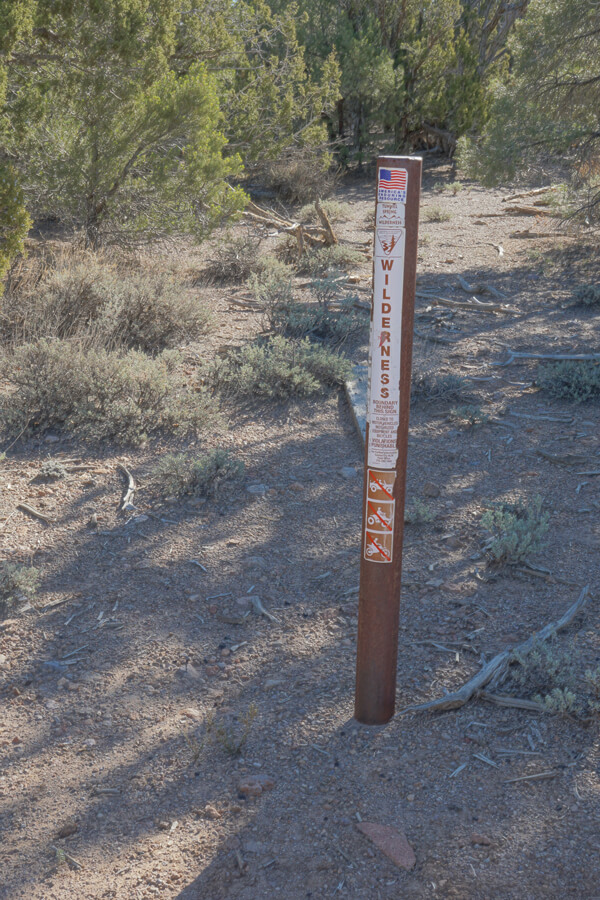
An aptly placed metal post in concrete may be more successful than a fiberglass sign post that can be easily laid over with a rock.
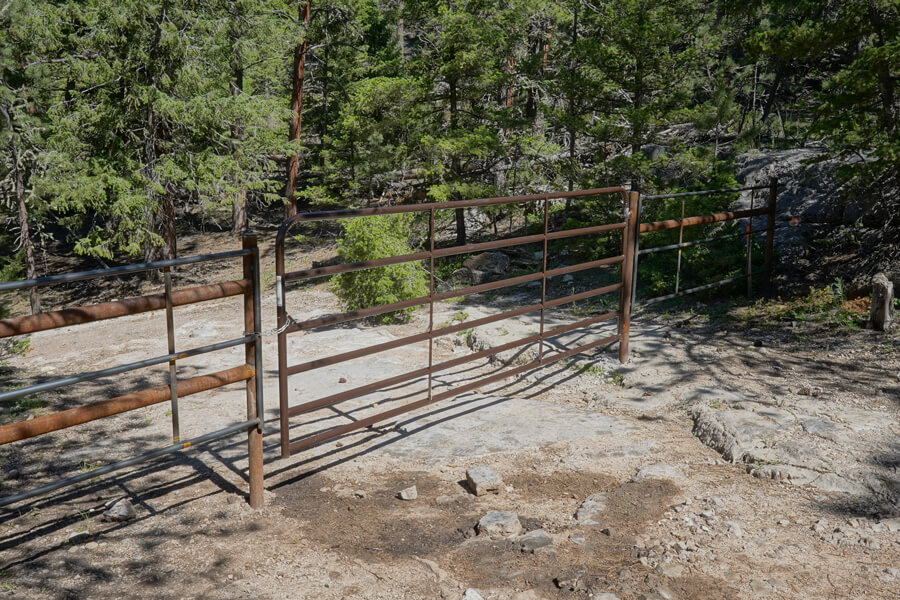
Gates should only be used where there is authorized vehicle access, such as to a private inholding. Where there is authorized vehicle access, gates must be installed, as such access routes are not open to the general public. The positioning of this gate to tie into the adjacent slope and vegetation greatly improves its effectiveness.
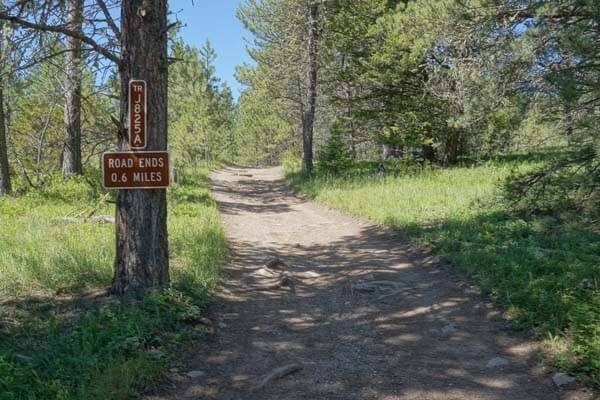
Giving motor vehicle users ample advance warning that a route ends improves compliance, and is especially useful where a gate is required, or other closures are more likely to be thwarted.
Some routes existing prior to wilderness designation were constructed, include large road features, may be in a soil type that is not conducive to natural restoration, or may have other conditions which require a more intensive restoration approach than the visual barrier technique described above. The MRA process is essential in considering these situations. For example, where a large cut and fill road exists, the land may first need to be recontoured to assure it does not significantly disrupt the hydrology of the site or present a long-term sediment source harmful to aquatic ecosystems. In addition, pre-existing culverts should be removed because without maintenance culverts can become plugged causing the old road to become a dam, and eventually will blow out. This can cause considerable damage downstream by scouring and contributing high amounts of sediment to streams. See the Ecological Intervention and Site Restoration Toolbox and the Small-Scale Restoration section for more detailed information.

Culvert removal on what was once a constructed and maintained road, but is now a wilderness area.
In some soil types, eliminating vehicle use will not naturally result in vegetation return due to loss of top soil, water flow, or soil compaction. Extensive management intervention may be necessary to break up soil compaction, prevent water from moving down the route, or other actions to slow water and provide seed germination sites.
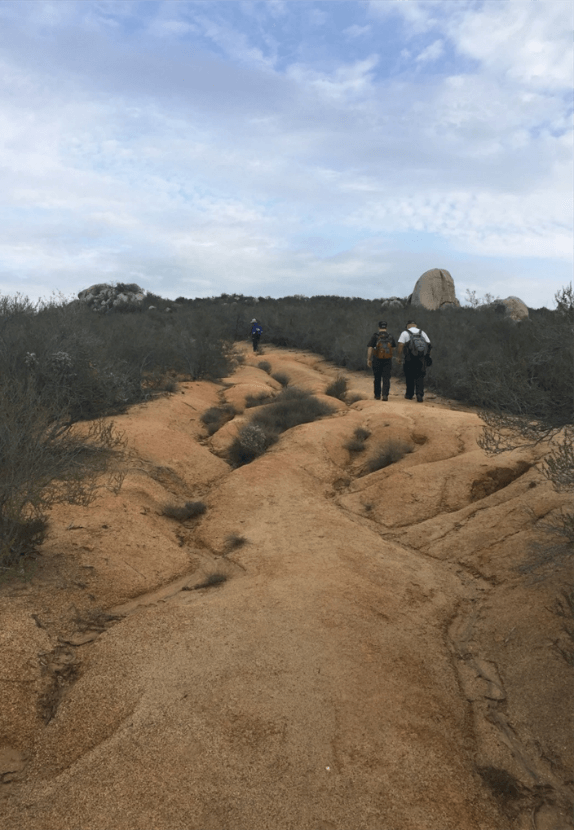
Vehicles have not been driven on this route for many years because of a physical barrier placed below. However, revegetation has not occurred due to soil compaction and runoff capture.
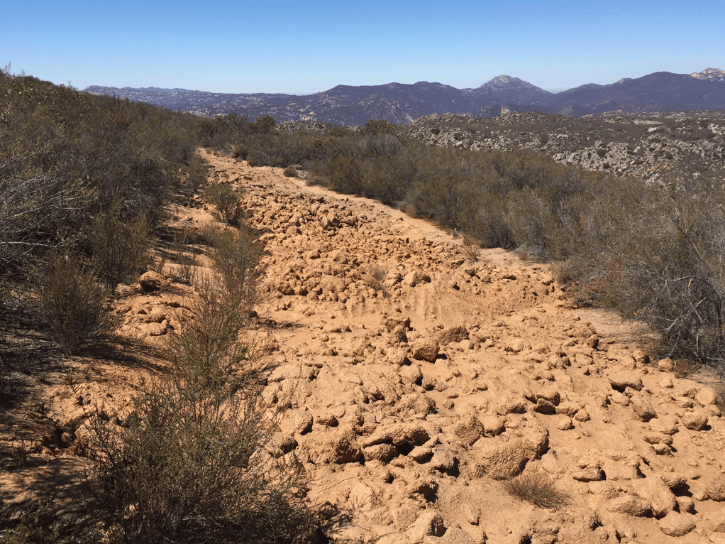
After motorized equipment work, soils are no longer compacted and surface texture was created to slow water movement and improve infiltration. This treatment creates safe sites for plant seed to germinate, improves soil moisture availability for germinating seeds, and allows plant roots to penetrate.
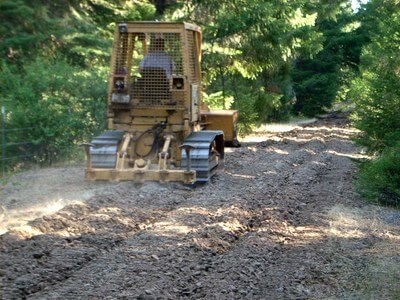
Breaking up soil compaction with heavy equipment on what was once a constructed and maintained road may be necessary to reclaim some sites.
In some cases, a route may also serve excepted purposes; such as access to a valid occupancy or authorized facility (e.g. radio repeater or livestock facility). In these cases, a gate as described in the preceding tab may be warranted. However, note that a route to a facility may still be closed and rehabilitated where irregular motor vehicle access is necessary. Facility maintenance may be provided by cross-country means in an alternate location. For example, a livestock reservoir may only need to be cleaned out every ten years. Keeping a vehicle route open to be used once every ten years, all the while attracting unauthorized use during that time period, would have a greater impact on the wilderness than a once-every-ten-year pass of a backhoe cross country. These situations are terrain-dependent and must be considered and determined through a Minimum Requirement Analysis on a case-by-case basis.
Summary
- A broad overall strategy to vehicle intrusion is essential. Applying several techniques is more likely to be successful than a single approach.
- Plausible strategies should be evaluated in a minimum requirements analysis to find the one that will provide the most benefits and least degradation to wilderness character.
- Success generally involves recurring tasks; for example, education, replacing signs, redoing/renewing a restoration treatment, community engagement, or maintaining a law enforcement presence. Expect to have a long-term commitment to preventing vehicle incursions.
- Everything can’t be done at once; preplan your strategy and task implementation. Take actions that are quickest, least costly, and reasonably sufficient first. For example, place signs first and install gates later.
- It is essential to monitor to determine effectiveness and improve wilderness protection. Monitoring will help you determine the optimal mix of techniques to apply to specific situations.
Aircraft (including drones and paragliders)
Section 4(c) of the wilderness act prohibits “landing of aircraft.”
Aircraft: “Aircraft means a device that is used or intended to be used for flight in the air” (14 CFR 1.1). This definition is found in the Code of Federal Regulations which apply to the Federal Aviation Administration. It is clear from this definition that aircraft also includes non-motorized flight (such as paragliders).
Landing: Not only is touchdown of the aircraft itself a landing, but any contact with something on the ground of anything originating from the aircraft or entering the aircraft is also a landing. For example, tranquilizer darting of wildlife from an aircraft is a landing. This is codified in agency regulations:
BLM: 43 CFR §6302.20(e) What is prohibited in wilderness? Land aircraft, or drop or pick up any material, supplies or person by means of aircraft.
FWS: 50 CFR §27.34 Aircraft. The unauthorized operation of aircraft, including sail planes, and hang gliders, at altitudes resulting in harassment of wildlife, or the unauthorized landing or take-off on a national wildlife refuge, except in an emergency, is prohibited.
FS: 36 CFR §261.18 The following are prohibited in a National Forest Wilderness: (c) Landing of aircraft, or dropping or picking up of any material, supplies, or person by means of aircraft, including a helicopter.
NPS: 36 CFR §2.17 Aircraft and air delivery. (a) The following are prohibited: (3) Delivering or retrieving a person or object by parachute, helicopter, or other airborne means, except in emergencies involving public safety or serious property loss, or pursuant to the terms and conditions of a permit.
The Wilderness Act contains a special provision in Section 4(d)(1) which states “the use of aircraft …where these uses have already become established, may be permitted to continue subject to such restrictions as the Secretary deems desirable.” This provides an exception to the blanket prohibition to the landing of aircraft if a planning decision has been made for a specific identified place where the use of aircraft was established before the designation of wilderness. The only established aircraft use in wilderness under the 4(d)(1) provision is associated with landing strips or helipads. All other public landing of aircraft is strictly prohibited, unless a right-of-way for landing exists. The landing of aircraft on a non-federal inholding in wilderness is not prohibited under Section 4(c).
What does it mean to be “established?” BLM policy provides the following guidance which may be informative to other agencies as well: “Generally, this provision applies to non-administrative public use associated with an identified facility (an airstrip or helispots) on the ground that was established prior to wilderness designation” (BLM Manual 6340 1.6 C.2(b)). An identified facility is normally one that is physically recognized and was analyzed and permitted prior to wilderness designation through a planning decision.
A common mistake is applying Section 4(d)(1) to agency use. 4(d)(1) only applies to public use. Agency use of aircraft can only occur if it is necessary to meet minimum requirements for the administration of the area for the purpose of the Wilderness Act.
Aircraft use over wilderness areas is not regulated by the Wilderness Act. In addition, most recent wilderness enabling laws typically include specific language disallowing restrictions to military overflight (e.g. “Nothing in this subsection restricts or precludes… low-level overflights of military aircraft over the wilderness areas, including military overflights that can be seen or heard within the wilderness areas"). Though the FAA has established a 2,000 foot above-ground minimum altitude advisory, it is only an advisory, pilots may exercise discretion whether or not to abide by it. Wilderness administrators should monitor and document low-level aircraft activity. There may be opportunities to adjust flight paths for general, commercial, and military aviation when the FAA or military initiate flight planning work; coming to the table with monitoring documentation will help to engage.
Management issues related to aircraft types
General: Because this type of transportation is non-motorized, it is often misunderstood as allowable in wilderness. In actuality, these type of aircraft are prohibited from takeoff and landing in wilderness. These activities are often described by proponents as compatible with wilderness because there is little to no impact to soil and vegetation – especially in comparison to impacts from other forms of recreation. However, impact to wilderness character is not limited to soil and vegetation impact - as with other recreational activities, impacts to solitude is an area of concern.
Definitions: Is the use of a wingsuit considered “aircraft,” and thus prohibited by the Wilderness Act? Yes, a wingsuit meets the definition of aircraft in 14 CFR 1.1 as a device used for flight (see above definition). Consider the Wikipedia description of wingsuit flight: “Wingsuit flying (or wingsuiting) is the sport of skydiving using a webbing-sleeved jumpsuit called a wingsuit to add wetted area to the diver’s body and generate increased lift, which allows extended air time by gliding flight rather than just free falling.”
Monitoring: Mostly this activity is monitored in the field. However, also look for videos and web posts to identify if this activity is beginning in the wilderness you manage.
- Example Video:
- mention the option for staff to follow up with the video host/creator to educate them or take enforcement action against subjects depicted?
Communication: Include information on websites and brochures for wilderness areas where there are attractive features or areas for this type of activity. Paraglider pilots seek steep open grassy slopes with good exposure to steady breezes. Wingsuit pilots seek tall open cliffs. Hang glider take-off in wilderness would be unusual because of the weight of the aircraft that must be carried in, but a boundary road near a high open ridge may be desirable to hang glider pilots. Consider providing information for wilderness areas with these characteristics.
Related uses: Participants to these activities might also utilize motorized transport to access launch zones or for retrieval once landed.
Resources: This article makes several mistakes including not recognizing that numerous NPS and BLM federal land areas are designated as wilderness where aircraft landing is prohibited under Section 4(c) of the Wilderness Act. However, the article helps to provide awareness for the topic.
General: Drones are prohibited from landing and take-off in wilderness as are all other aircraft. In addition, because they are also motorized equipment, operating a drone from within wilderness is prohibited – in other words, where the takeoff and landing occurs outside of wilderness but the operator is controlling the aircraft from within wilderness. A mere flight over wilderness when the controller is also outside the wilderness is not prohibited simply because the area is wilderness, though it is discouraged because of the impact it can have on wilderness character (e.g. visitors solitude and wildlife) and because it runs counter to the FAA’s advisory for aircraft to remain at least 2,000 feet above ground level when flying over wilderness. Agency staff considering agency-operated drone overflight of wilderness should consider the impact of such use before engaging in it (see your agency policy for analysis requirements).
Definitions: Popularly known as drones and formally described as Unmanned Aircraft Systems (UAS), they do not carry a human operator and normally carry a payload, the payload often being a camera or specialized sensors to collect data.
Monitoring: Mostly this activity is monitored in the field. However, also look for videos and web posts to identify if this activity is beginning in the wilderness you manage.
Communication: kiosks, websites, and brochures.
Related uses: Drone technology is expected to continue to advance and with advancement could bring the ability to carry payloads for delivery into remote Wilderness locals. Though it would be illegal, prohibiting payload delivery could be difficult to enforce. In addition, drone technology is expected to make its way into human transport as well. See the section on helicopters.
Resources
General: Helicopter landings may be uncommon. Still, documented illegal helicopter landings occur every year in the NWPS. Helicopter landing is more likely to occur in wilderness than fixed wing aircraft due to the space required.
The 4(d) provision allowing the established use of aircraft to continue is important to consider here. Helicopters undoubtedly landed in numerous places prior to wilderness designation. The mere landing of helicopters, however, does not establish it as an allowable use under the special provision. Landing must be public use associated with an identified facility.
Drone technology is expected to make its way into human transport as well. Drones operate on a rotary wing principle. Should the technology develop so that it is safe and inexpensive, wilderness managers can expect to see overflight issues as well as illegal landings. Both occurrences would cause significant impacts to wilderness character and would be difficult to control.
Definitions: any rotary wing aircraft.
Monitoring: Occurrences may be observed by field staff but most likely will be observed by the public and then reported. Providing information on kiosks so that the public knows how to report observed landings, such as where, what, when, and identification numbers, while cautioning the public to not make contact with those involved, is an important way to monitor.
Communication: Assure that wilderness areas are identified on aeronautical charts. Many visitors are not informed about legal aircraft use in wilderness. Complaints about overflights (military, commercial, and general aviation) may occur even though they are legal. Consider providing kiosk information on what visitors should expect where overflights are more common. If there is a potential for illegal aircraft landings, provide information on kiosks for visitors to report (where, what, when, and identification numbers) observed landings.
Related uses: The most common occurrence of helicopter incursions is related to hunting and fishing.
Resources: Hunting rules and regulations of state agencies generally prohibit hunting from aircraft or the harassment of wildlife by aircraft.
General: The Wilderness Act contains a special provision in Section 4(d)(1) which states “the use of aircraft …where these uses have already become established, may be permitted to continue subject to such restrictions as the Secretary deems desirable.” This provides an exception to the blanket prohibition to the landing of aircraft, if a planning decision has been made at places where the use of aircraft was established before the designation of wilderness. Public landing of aircraft in other locations is prohibited, unless a right-of-way for landing exists. The landing of aircraft on a non-federal inholding in wilderness is not prohibited under Section 4(c). The only established aircraft use in wilderness under the 4(d)(1) provision is associated with pre-existing landing strips or helipads.
There may also be provisions for aircraft landing in enabling legislation. For example, ANILCA allows for the landing of float planes in Alaska (The ANILCA provision does not apply to any wilderness outside Alaska).
Facilities associated with allowable aircraft landing may be maintained. Standard maintenance may include: clearing (e.g. trees or brush); mowing; periodic grading; and, keeping wind socks operational. Maintenance activities are determined through a Minimum Requirements Analysis, and typically work is carried out without motorized equipment, despite the maintenance being done to support motorized transportation. For example, grading an airstrip would usually occur using horse-drawn implements. For more information on managing aircraft use allowed under a special provision, take the online course, Managing Special Provisions: Aircraft and Motorboats.
Aircraft sometimes crash in wilderness and must be removed. Sometimes there is an urgent immediate need for rehabilitation such as the recovery of unexploded munitions from a military aircraft crash. Though not an immediate urgent need, aircraft crashes also require accident investigations in a timely manner to assure the cause of the crash is not a threat to other aircraft of the same type. These instances may necessitate the landing of aircraft to investigate the scene and to remove aircraft pieces so that they can be more carefully examined in a controlled site.
After a crash, the National Transportation Safety Board and/or the FAA will investigate, before the wreckage can be removed. After the investigation, it is the responsibility of the owner (normally through the assistance of the insurance company) to remove the wreckage. The agency will identify removal methods through a MRA to accomplish the task with the least impact to wilderness character.
Aircraft crashes, especially military aircraft, may create hazards such as soil contamination and exposure to debris that may contain hazardous materials. Aircraft, especially military aircraft, are increasingly made of numerous composites that may pose a hazardous material concern. In addition, there may be fuel, oils, and live munitions on the aircraft. Some of these materials need to be rendered safe on-site before they are removed. Finally, there may be scars on the land from the impact that need to be rehabilitated. Crashes can be an attractive nuisance leading to impacts from visitors wanting to explore the site. If it is a military crash, there may be classified information involved, which will require guarding the site. Crashes involving these factors will demand specialized clean-up measures which may include temporary helicopter landing areas, use of motorized equipment on site, staging sites, accommodations for guards, and other measures otherwise prohibited in Section 4(c) of the Wilderness Act. Wilderness managers may have little jurisdictional authority immediately after such an event (especially when classified military information is involved). Wilderness management agencies should immediately initiate agreements with the responsible agency/entity so as to provide means by which to participate with crash response officials and integrate wilderness information into the crash response.
Definitions: An aircraft with wings that remain stationary while generating the aircraft’s lift.
Monitoring: It is unlikely that fixed wing aircraft will land in most wilderness areas simply due to the large amount of flat land surface required. Where such areas exist, emphasize monitoring to detect aircraft landing.
Communication: Assure that wilderness areas are identified on aeronautical charts. Many visitors are not informed about legal aircraft use in wilderness. Complaints about overflights (military, commercial, and general aviation) may occur even though they are legal. Consider providing kiosk information on what visitors should expect where overflights are more common. If there is a potential for illegal fixed wing aircraft landing, provide information on kiosks for visitors to report (where, what, when, and identification numbers) observed landings.
Resources:
- Wilderness Connect Special Provisions toolbox
- Schafer Meadows Airstrip Project: 2020
- Schafer Meadows Airstrip Project: 2021 Update
Case Study: Death Valley Wilderness presentation on two military aircraft crashes.
Legal decisions: U.S. v. Gregg, 290 F.Supp. 706 (W.D. Wash. 1968) Page 114
General: Ultralight aircraft tend to be personal aircraft which combine elements of two of the categories above; for example, motorized paragliders. They fly low and slow. These aircraft can be highly disruptive to wilderness settings. Though often a specialty type of aircraft not widely encountered, they may have very dedicated individuals or clubs engaged in the activity, which may be a localized phenomena. They can be landed and taken off from very small openings. Often times they don’t land, but instead fly mere feet above the ground. Videos sometimes show pilots dragging their feet on the ground. Landing is a violation of the Wilderness Act, but flying at low elevations is not. Consequently, the public and agency staff can be very frustrated with the impact ultralight aircraft can have on wilderness character, but may lack the authority or means to address the activity.
Definitions: An ultralight has only one seat, weighs less than 254 pounds, has a maximum fuel capacity of 5 gallons, does not exceed 63 mph, has a power-off stall speed less than 28 mph, can only be flown between sunrise and sunset, does not need to be marked or registered with the FAA, does not require a pilot’s license, and the pilot does not need to possess aeronautical knowledge or experience, or be of a certain age.
Monitoring: Mostly this activity is monitored in the field. However, also look for videos and web posts to identify if this activity is beginning in the wilderness you manage.
Example: King Range Wilderness: Powered Paragliding Video
Communication: Provide information on kiosks for visitors to report (where, what, when, and identification numbers) of observed landings (including any contact with the ground).
Snowmobiles
Snowmobile incursions have increased since the early history of the Wilderness Act and occur in nearly every wilderness that has enough snow to support snowmobiling. The increase is a result of improved technology and greater horsepower which makes it possible to travel on unpacked snow and steeper terrain. More dependable engines, cellphones, and GPS have also increased rider confidence, which leads to riders exploring more remote and challenging terrain. Lack of understanding of, or, lack of support for wilderness can lead to both inadvertent and intentional incursions.
Inadvertent incursions occur when:
- operators have a lack of awareness of boundaries
- boundaries are difficult to see or find
- following incorrect information from maps which have not been updated or show the boundaries
- misinformation is shared
To prevent inadvertent trespass, the agency must ensure riders know that 1) snowmobile use is prohibited in wilderness; and 2) where the actual boundaries of wilderness areas are.
Intentional trespass occurs with snowmobile riders who:
- have a disregard of authority or a tendency to flaunt the law
- desire to ride in an untracked area or otherwise “poach” what is seen as a premium experience
- do not agree that snowmobiling in wilderness harms the resource
- don’t believe any other recreationists are present in winter and so no-one will be disturbed
- believe the odds of being caught and ticketed are low, and the consequences of being caught is minimal
The only way to prevent intentional trespass is apprehension and prosecution. Impediments to managing an effective enforcement program include expense and patrol constraints. An enforcement program requires a large investment in equipment and personnel training. Motorized patrol within wilderness boundaries is not appropriate, and so observation for incursions must be done from boundaries where visibility may not be optimal or within the wilderness by non-motorized transport where it may be difficult to contact the violator. However, law enforcement officers may use (without prior approval) motor vehicles in hot pursuit of a violator where not doing so would endanger their life, the lives of others, or would lead to the escape of the alleged perpetrator.
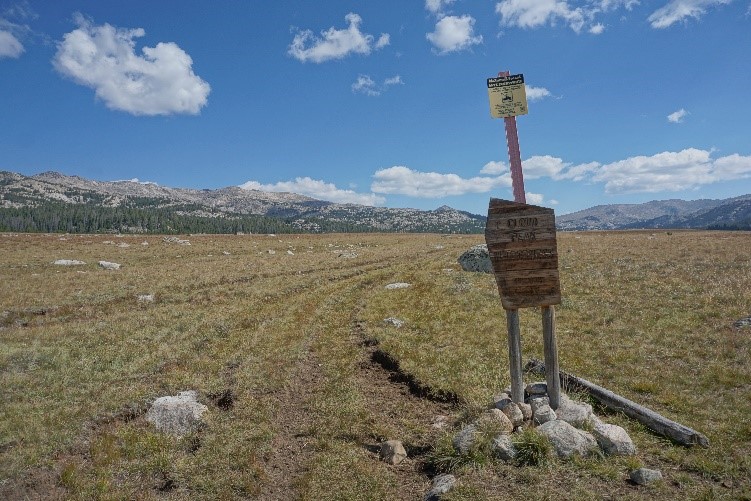
Wilderness boundary sign with an extension to be visible to snowmobilers when snowpack buries the sign.
Impacts of snowmobiles to the wilderness resource include:
- Noise which impacts solitude and wildlife.
- Snow compaction which can crush the subnivean zone which is critical to many animals during the winter.
- Compacted snow and ice under routes can take longer to thaw and melt, resulting in a lingering visual indicator of their presence.
- Search and rescue need and availability.
Resources:
- Information and education techniques include:
Motorboats
The Wilderness Act contains a special provision in Section 4(d)(1) which states “the use of… motorboats, where these uses have already become established, may be permitted to continue subject to such restrictions as the Secretary deems desirable.” This provides an exception to the blanket prohibition to motorboats in Section 4(c). Though the special provision allows for motorboat use where established, the use is subject to restrictions the Secretary deems desirable. What does it mean to be “established?” The Wilderness Management Plan for an individual wilderness must identify where motorboat use was established before the wilderness was designated. The simple ability of waters in the wilderness to support motorboat use is insufficient to deem it established. Generally, there should have been facilities in place prior to wilderness designation that support the use. Many wilderness areas where larger water bodies are present also have special provisions in their enabling law providing specific allowances and limitations for motorboats.
Some water ways may be under state jurisdiction rather than the federal agency, and so not within the control of the wilderness manager. Identify opportunities to work with state agencies to manage waterways consistently with the wilderness designation. There simply are not many opportunities for non-motorized wilderness boating thus, efforts should be made to ensure that wilderness areas can provide opportunities for those experiences.
Facilities associated with allowable motorboat use may include docking or pull out areas, trails, camping platforms or areas, and toilets to contain human waste and protect water quality. These may be constructed, retained and maintained if they are necessary for preserving wilderness character. For example, a dock may be necessary to protect shorelines from loss of vegetation. Activities are determined through a Minimum Requirements Analysis, and typically such work is carried out without motorized equipment, despite the maintenance is to support motorized transportation.
For more information on managing motorboat use allowed under 4(d)(1) of the Wilderness Act, take the online course, Managing Special Provisions: Aircraft and Motorboats.
Bicycles (including other wheeled conveyance)
Section 4(c) of the Wilderness Act prohibits the use of mechanical transport. This prohibition has been the source of debate, with some arguing that bicycles are not mechanical transport. Consider the following dictionary definitions:
- Mechanical: operated by machinery
- Machine: an apparatus of interrelated parts with separate functions
- Simple Machine: lever, wheel and axle, pulley, screw, wedge, and inclined plane
- Transport: To cause to go over some distance from one place to another.
Bicycles meet these definitions and the intent of the prohibition of mechanical transport is to prohibit bicycles in wilderness. However, the prohibition is not limited to bicycles, it also includes game carts, wheelbarrows, strollers, boat dollies, wheeled coolers, and other similar wheeled conveyances.
The prohibition to mechanical transport, however, does not apply to wheelchairs. The Americans with Disabilities Act, Title V Section 508 (C) states: “(1) In general. Congress reaffirms that nothing in the Wilderness Act is to be construed as prohibiting the use of a wheelchair in a wilderness area by an individual whose disability requires use of a wheelchair, and consistent with the Wilderness Act no agency is required to provide any form of special treatment or accommodation, or to construct any facilities or modify any conditions of lands within a wilderness area in order to facilitate such use. (2) "Wheelchair" defined. For purposes of paragraph (1), the term "wheelchair" means a device designed solely for use by a mobility-impaired person for locomotion, that is suitable for use in an indoor pedestrian area.”
Bicycle incursions have seen significant increases in the past 30 years. When the Wilderness Act was enacted, bicycles were not easily used in wilderness. Significant advancements in bicycles, including lighter materials, improved gearing, suspension, and other improvements have made bicycles capable of easy use in wilderness. With these advancements, the mountain bike has seen an explosion in use levels outside of wilderness, but also trespass activity in wilderness.
The majority of cyclists and other visitors using mechanical transport want to do the right thing; that is, not violate the Wilderness Act. However, a lack of understanding of wilderness can lead to inadvertent incursions. To prevent inadvertent use of mechanical transport in wilderness, the agency must ensure visitors first know that mechanical transport is prohibited and second what mechanical transport is. A primary method of doing this includes signing and mapping, and providing explanations on map legends, brochures, and kiosks. Also consider producing websites, information packets, fact sheets, or brochures. Many user groups and communities will incorporate this same information into their own maps and materials. Work with local user groups and outfitters to educate riders on where they can go to find the experiences they seek. Be sure to describe Public Lands as a spectrum of resources, values and benefits, with wilderness filling a specific niche, and identify the continued availability of non-wilderness opportunities (for example, inform visitors of where nearby high-quality mountain bike trails exist).
Not every cyclist or visitor, however, wants to do the right thing. Intentional mechanical transport incursions occur where there is a lack of support for Wilderness and these are more difficult to prevent. Intentional incursions tend to be made by visitors who:
- do not agree that mechanical transport includes bicycles or other wheeled conveyances
- do not agree that wheeled conveyance harms the resource
- see themselves as allies in protecting natural areas, and at the same time unfairly excluded from them
- desire to “poach” what is considered a premium experience
- believe the odds of being caught and ticketed are low, and the consequences of being caught is minimal
- have a disregard of authority or a tendency to flaunt the law
More defensive approaches are necessary to prevent intentional trespass including apprehension and prosecution. There must be signs at reasonable places, such as trailheads, providing the regulation in effect in order for Law Enforcement Officers to issue citations. The largest impediment to apprehension and prosecution is the time requirements for LEO staff. Developing a patrol strategy includes identifying the timing of the use seasonally, day of the week, and time of day. Characteristics of groups is also important, in that citations issued to club members in random but persistent timing can help spread the word throughout the club that enforcement is active. Issuing reports on the number of citations to local newspapers can help spread the word to unaffiliated riders. Identify areas with particular vulnerability and with repeated intrusions, and focus law enforcement attention there.
Resources:
Prevention
To protect the wilderness from vehicle trespass it is necessary to consider the type of vehicle(s) involved, the timing of the use, the purpose of the use (e.g. general vehicle play or access to a feature), the setting (e.g. landform and vegetation type, and the land uses and access adjacent to the wilderness), and the characteristics of the user groups. A successful intervention strategy considers all of these elements and selects a combination of signing, mapping, restoration, barricading, identification of alternative sites, conversion to appropriate uses, off-site information, education, law enforcement, or other tools appropriate to the situation. For newly designated wilderness, provide high-quality agency specific maps as soon after designation that clearly identifies boundaries.
Law Enforcement
The standard for issuing a citation for vehicle use in wilderness is that a person knowingly and willingly violated the Wilderness Act. In trial the agency must prove that a violation occurred within wilderness and that the defendant knew the area was designated as wilderness. There is no requirement that the defendant knew the operation of a vehicle in wilderness is illegal. However, the standard for a jury to find a defendant guilty is that it is beyond a reasonable doubt that a violation occurred. Consequently, the more detail that the agency can provide to show the defendant had ample information available that motor vehicles are prohibited in wilderness, the easier it is for a jury to conclude the defendant is guilty. The presence of signs, the availability of maps, and other information that identify the wilderness and the prohibition of vehicle use are important to making a sound case that a violation occurred beyond a reasonable doubt. When violations occur on the edges of the wilderness, the area must have been surveyed with the boundary signs precisely located based on the survey to prove the violation occurred beyond a reasonable doubt. Usually citations are issued when the violation occurred well within the boundary of the Wilderness area, and though this mitigates the need to have precisely located boundary markers, the agency will still have to prove the activity was within wilderness, and that the defendant knew the area was within wilderness. The presence of signs, maps, and legal descriptions will be relied upon to prove that there was no question that the defendant knowingly and willingly violated the Wilderness Act.
Law enforcement resources
- Interagency agreements to facilitate better coverage.
- Law Enforcement and the Authority of the Resource, Wallace et al
Case law
Agency Guidance
Per 43 CFR 1733(a), the Secretary shall issue regulations necessary to implement the provisions of FLPMA with respect to the management, use, and protection of the public lands, including the property located thereon. Any person who KNOWINGLY and WILLFULLY violates any such regulation which is lawfully issued pursuant to FLPMA, shall be fined no more than $1,000 or imprisoned no more than twelve months, or both. The BLM regulations on prohibited uses in wilderness can be found in 43 CFR Section 6302.20. The use of motorized vehicles and mechanical transport is prohibited in 43 CFR 6302.20(d).
The legal standard for issuing a federal violation notice is probable cause, which can be described as a reasonable basis for believing that a specific subject has committed a violation. Some violators receiving violation notices will treat it as a learning lesson and simply pay the fine. However, should a subject wish to contest the violation notice and insist that the government prove the facts of the alleged violation, the legal standard for obtaining a conviction at trial is “proof beyond a reasonable doubt”. Thus, the government must prove beyond a reasonable doubt that the subject (1) knowingly and willfully was present in wilderness, while (2) knowingly and willfully using the equipment. The government need not prove that the subject knew that using the vehicle in wilderness was prohibited.
To be successful in obtaining a criminal conviction at trial, it is imperative to show the jury that the defendant knew the vehicle use occurred within the wilderness, and although it’s not required to prove the defendant knew the use was illegal in the wilderness, juries are more likely to convict defendants when the defendant’s intent to violate the law was obvious. This can be achieved by posting boundary markers and regulations on the ground, ensuring maps are readily available online and at entrance portals, and making outreach efforts to user groups to inform them of wilderness boundaries. Those steps can make the claim that, “I didn’t know”, less credible.
Further, law enforcement officers can increase the success of their enforcement actions by targeting gross violations where incursions are significantly within the boundaries of the wilderness area. When violations occur right at the boundary, especially where surveys have not been conducted and the boundary is not precisely located, officers may be better served by issuing warnings and educating suspected violators.
Please note that the content pertaining to FWS is currently unavailable but will be promptly included as soon as it becomes accessible.
Please note that the content pertaining to FS is currently unavailable but will be promptly included as soon as it becomes accessible.
Please note that the content pertaining to NPS is currently unavailable but will be promptly included as soon as it becomes accessible.
Agency Policy
BLM Manual
6340
1.6 C.2 The landing of aircraft within wilderness areas is governed by sections 4(c) and 4(d) of the Wilderness Act and discussed in section .06 B of this manual. Also, by regulation, at 43 CFR 6302.20 (e) (“What is prohibited in wilderness?”) landing is a prohibited use in wilderness and is defined as "drop[ping] or pick[ing] up any material, supplies, or person by means of aircraft, including a helicopter, hang-glider, hot air balloon, parasail, or parachute." Therefore, launching any form of aircraft from a wilderness is prohibited, except as may be allowed in the exceptions described below. See also sub-section B.2.g of this Manual.
Generally, landing of aircraft can only be allowed as necessary to meet minimum requirements for the administration of the area for the purpose of preserving wilderness character (See section 1.6 B of this manual), including measures required in emergencies involving the health and safety of persons within the area. The exception to the general prohibition on aircraft use also includes some law enforcement actions. See also sections 1.6.C.10 and 1.6.C.17 of this manual. Section 4(d)(1) of the Wilderness Act states that “the use of aircraft …where these uses have already become established, may be permitted to continue subject to such restrictions as” the BLM “deems desirable.” Generally, this provision applies to non-administrative public use associated with an identified facility (an airstrip or helispots) on the ground that was established prior to wilderness designation. The BLM has discretion to either allow or prohibit the continuation of aircraft use where it has already been legally established prior to the designation of a wilderness area. Administrative use of aircraft is normally authorized under section 4(c) of the Wilderness Act, only where it is necessary to meet minimum requirements for the administration of the area for the purpose of the Wilderness Act. (Note that the 4(d)(1) provision also applies to public use of motorboats, which do not have their own sub-section in this manual because their use is so rare in BLM wilderness areas.)
1.6.C.9.b.i. Inholders will be given a right to adequate and reasonable access to their inholdings. Adequate and reasonable access is defined as the access that was enjoyed by the inholder on the date Congress designated the area surrounding the inholding as wilderness. This right is limited to the route and modes of travel used by the inholder at the time of designation, which should be determined and documented by the BLM as soon as possible after designation. Documentation of the access should be added to the wilderness area's permanent case file. (see 43CFR 6305.10)
1.6.C.10. Law Enforcement.
- Background. Law enforcement actions that may take place within wilderness (outside of search and rescue missions, detailed in section 1.6.C.17) include actions: immediately involved in "hot pursuit," taken to investigate accidents or illegal activities, taken to rehabilitate wilderness as a result of an accident or illegal activities, and taken in support of the security of international borders.
- General principles. It is the BLM's objective to preserve wilderness character to the maximum extent possible while allowing necessary law enforcement actions regardless of whether those actions are taken by BLM law enforcement personnel or by officers from another agency. The BLM is encouraged to develop Memoranda of Understanding and other cooperative tools to facilitate coordination with law enforcement agencies (for example, with appropriate State agencies on enforcement activities associated with reporting fish and wildlife violations).
- Specific implementation. The BLM will use the following guidelines in managing law enforcement operations within wilderness areas: i. "Hot pursuit." Under the "emergencies" exception to the 4(c) prohibited uses, law enforcement officers of the BLM or other federal, tribal, state, or local agencies may use, without prior approval from a BLM Line Officer, any prohibited tool in a wilderness when not doing so would endanger their lives or the lives of others or would lead to the escape of the alleged perpetrator. As soon as possible after a hot pursuit incident in which a 4(c) prohibited use was employed, the BLM law enforcement officer (or other law enforcement agency) will notify the BLM District or Field Manager and submit a written report that includes:
- the date(s) of the action
- the location of the action
- the nature of the initial report and, if different, the nature of the actual situation
- the number of responding personnel, and the number, type, and amount of use of any prohibited tool
ii. Investigations. In the case of accident investigations, investigations of wildlife law violations, or criminal investigations not involving "hot pursuit," prior approval from a BLM Line Officer is required for any law enforcement officers of the BLM or other federal, tribal, state, or local agencies to use any generally prohibited tool in a wilderness. Due to the sensitive nature of such investigations, completing a documented Minimum Requirements Analysis as outlined in Appendix B is not required, but the BLM Line Officer should be satisfied that the use of the prohibited tool is in fact the "minimum necessary." The Line Officer in question is usually the Field Manager but, depending on the sensitivity of the investigation, may be the District Manager, State Director, or BLM Director. For NEPA requirements, see the BLM NEPA Handbook (Handbook H-1790-1), section 2.3 (Emergency Actions) and Appendix 3 (Departmental Categorical Exclusions), which apply to arrests and investigations. As soon as possible after the investigation, subject to exceptions necessary due to on-going legal actions, the BLM law enforcement officer (or other law enforcement agency) should submit a written report to the Line Officer that includes:
- the date(s) and location(s) of the investigation
- the name of the approving BLM official
- the purpose of the investigation (except when disclosure would compromise on-going legal actions)
- the number of personnel involved, and the number, type, and amount of use of any prohibited tool
iii. Rehabilitating results of accidents or illegal activities. Though usually not emergencies, the results of accidents or illegal activities will be rehabilitated as soon as possible. There are two types of rehabilitation in the context of law enforcement, urgent and non-urgent rehabilitation. Employing any tool prohibited by Section 4(c) of the Wilderness Act will require the use of the MRDG in all cases involving non-urgent rehabilitation. Examples of urgent rehabilitation include: cleaning drug production sites where dangerous chemicals or other materials are present that pose an imminent danger to human safety or the environment, or recovering unexploded bombs from a military aircraft crash. Examples of non-urgent rehabilitation include: dismantling drug production/cultivation sites where no immediate safety or health hazards are present or recovering non-explosive and non-toxic airplane wreckage. Using relevant authorities, every effort should be made to recover the costs of rehabilitation from the perpetrator(s). However, inability to identify a perpetrator, or the perpetrator’s inability to pay for rehabilitation, is not a sufficient rationale for not rehabilitating the impacts. See also section 1.6.C.15 of this manual.
iv. U.S. Border issues. As a result of the Illegal Immigrant Responsibility Act of 1996 (as amended in 2005 by Section 102 of the Real ID Act), actions taken to build barriers and associated roads in order to secure international borders are exempt from many restrictions that might be imposed by the Wilderness Act, including the general Congressional direction to "preserve wilderness character." All actions should be undertaken within the framework provided by the latest Memorandum of Understanding (MOU) among the U.S. Departments of Homeland Security, Interior, and Agriculture Regarding Cooperative National Security and Counterterrorism Efforts on Federal Lands along the United States’ Borders. The overarching goal of the MOU is to secure the borders of the United States and address emergencies involving human health and safety, while preventing or minimizing environmental damage arising from cross-border illegal entry on public lands. For further direction, see the most recent MOU.
1.6.C.13.c.ii. Trails and trail systems. Existing trails must be evaluated to determine if they are the minimum necessary to preserve wilderness character. Trails may be relocated or closed and restored as a result of the evaluation. The evaluation should include closure or consideration of conversion to hiking trails of any existing motorized routes, abandoned logging roads, old firebreaks, etc.
1.6.C.13.c.iii. Signs. Only a minimum of signs should be installed within wilderness areas. Instead, emphasis should be on making accurate maps, route descriptions, or brochures available to visitors.
1.6.C.15.f.ii.A. Restoration of site specific disturbances. Restoration of pre-designation human impacts, authorized disturbances, or violations normally includes treatments to restore the appearance of site specific areas and to promote regrowth of native vegetation on the disturbed site.
Regulations
Motor Vehicle Use in Wilderness
36 CFR Sec. 293.6 Commercial enterprises, roads, motor vehicles, motorized equipment, motorboats, aircraft, aircraft landing facilities, airdrops, structures, and cutting of trees.
Except as provided in the Wilderness Act, subsequent legislation establishing a particular Wilderness unit, or Secs. 294.2(b), 294.2(c), and 294.2(e), paragraphs (c) and (d) of this section, and Secs. 293.7, 293.8, and 293.12 through 293.16, inclusive, and subject to existing rights, there shall be in National Forest Wilderness no commercial enterprises; no temporary or permanent roads; no aircraft landing strips; no heliports or helispots, no use of motor vehicles, motorized equipment, motorboats, or other forms of mechanical transport; no landing of aircraft; no dropping of materials, supplies, or persons from aircraft; no structures or installations; and no cutting of trees for nonwilderness purposes.
Agency Regulation
BLM: 43 CFR 6302.30 - What penalties apply if I commit one or more of the prohibited acts? (a) If you commit a prohibited act listed in Sec. 6302.20 in a BLM wilderness area, you are subject to criminal prosecution on each offense. If convicted, you may be fined not more than $100,000 under 18 USC 3571. In addition, you may be imprisoned for not more than 12 months, as provided for by 43 USC 1733(a). (b) At the request of the Secretary of the Interior, the United States Attorney General may institute a civil action in any United States district court for an injunction or other appropriate order to prevent you from using public lands in violation of the regulations or this part.
Please note that the content pertaining to FWS is currently unavailable but will be promptly included as soon as it becomes accessible.
Please note that the content pertaining to FS is currently unavailable but will be promptly included as soon as it becomes accessible.
Please note that the content pertaining to NPS is currently unavailable but will be promptly included as soon as it becomes accessible.
Partnerships
In 1999, the California Desert District of the BLM successfully applied for a grant from the Division of Off-Highway Motor Vehicle Recreation of the California Department of State Parks and Recreation. Approval of the grant was due to support from a wide variety of desert recreational users, including off-highway vehicle organizations who desired to have clarity between appropriate and inappropriate OHV areas, and improve their groups image by reducing OHV impacts to wilderness. The BLM utilized the grant money in an assistance agreement with the Student Conservation Association who recruited young, motivated volunteers to make contributions in the form of labor to create visual barriers. Some of the student volunteers used their experience as a part of continuing education, and some as a stepping stone into employment with the federal agencies. This partnership between a non-profit organization and a Federal and State agencies resulted in one of the most successful and well known wilderness management programs within the BLM.